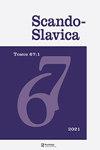Norwegian Compounds and Corresponding Constructions in Russian: The Case of Nouns with Deverbal Heads
IF 0.2
0 HUMANITIES, MULTIDISCIPLINARY
引用次数: 0
Abstract
ABSTRACT This article presents a corpus study of Norwegian compounds with deverbal heads (e.g., papirproduksjon ‘paper production’ from produsere ‘produce’) and corresponding constructions in Russian, such as the genitive (proizvodstvo bumagi ‘paper production’), the adjective (bumažnoe proizvodstvo ‘paper production’), the preposition (priglašenie na užin ‘dinner invitation’), and compound constructions (zemlevladelec ‘landowner’). Test of the “Non-Head Function Hypothesis” (Mezhevich 2002) indicates that the genitive construction is the most frequent equivalent of Norwegian compounds where the non-head functions as an internal argument (object). However, the adjective and compound constructions represent important competitors, while the preposition construction is more marginal. The genitive construction is shown to be particularly frequent for non-agentive nouns. A number of generalizations about the use of compounds are proposed, and it is argued that the adjective construction involves “typification,” which is an example of the general cognitive process “construal” (Langacker 2008). Finally, an “Extended Non-Head Function Hypothesis” is proposed, according to which the choice of a Russian construction depends on the closeness of the relation between head and non-head of the Norwegian compound. The closer the relation, the more likely is the use of the genitive. The more distant the relation, the more likely is the use of the adjective construction.俄语中挪威语复合词及其对应结构:名词带谓语词头的情况
本文对挪威语中带有词头的化合物(例如,papirprodukshjon的“纸生产”来自produsere的“生产”)和俄语中相应的结构进行了语料库研究,例如属格(proizvodstvo bumagi的“纸生产”)、形容词(bumažnoe proizvodstvo的“纸生产”)、介词(priglašenie na užin的“晚餐邀请”)和复合结构(zemlevladelec的“地主”)。“非词头功能假说”(Mezhevich 2002)的测试表明,在挪威语复合词中,属格结构是最常见的等价物,其中非词头作为内部参数(宾语)。然而,形容词和复合结构是重要的竞争对手,而介词结构则较为边缘化。属格结构在非代理名词中尤为常见。关于复合词的使用提出了一些概括,并且认为形容词结构涉及“类型化”,这是一般认知过程“解释”的一个例子(Langacker 2008)。最后,提出了一个“扩展的非词头功能假设”,根据该假设,俄语结构的选择取决于挪威复合词的词头和词头之间的关系是否密切。关系越密切,越有可能使用属格。关系越远,越有可能使用形容词结构。
本文章由计算机程序翻译,如有差异,请以英文原文为准。
求助全文
约1分钟内获得全文
求助全文

 求助内容:
求助内容: 应助结果提醒方式:
应助结果提醒方式:


